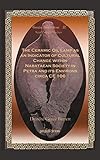The Ceramic Oil Lamp as an Indicator of Cultural Change within Nabataean Society in Petra and its Environs circa CE 106 / Deirdre Grace Barrett.
Material type: TextSeries: Gorgias Studies in Classical and Late AntiquityPublisher: Piscataway, NJ : Gorgias Press, [2008]Copyright date: ©2008Description: 1 online resource (204 p.) : 118Content type:
TextSeries: Gorgias Studies in Classical and Late AntiquityPublisher: Piscataway, NJ : Gorgias Press, [2008]Copyright date: ©2008Description: 1 online resource (204 p.) : 118Content type: - 9781593336288
- 9781463213985
- 730
- online - DeGruyter
| Item type | Current library | Call number | URL | Status | Notes | Barcode | |
|---|---|---|---|---|---|---|---|
 eBook
eBook
|
Biblioteca "Angelicum" Pont. Univ. S.Tommaso d'Aquino Nuvola online | online - DeGruyter (Browse shelf(Opens below)) | Online access | Not for loan (Accesso limitato) | Accesso per gli utenti autorizzati / Access for authorized users | (dgr)9781463213985 |
Browsing Biblioteca "Angelicum" Pont. Univ. S.Tommaso d'Aquino shelves, Shelving location: Nuvola online Close shelf browser (Hides shelf browser)
Frontmatter -- Table of Contents -- List of Illustrations -- Preface -- Abbreviations -- 1. Introduction and Theoretical Concerns -- 2. The Geography and History of Nabataea -- 3. Sacred and Ceremonial Sites -- 4. The Ceramic Oil Lamp, Function, Form and Type -- 5. Distribution of Lamps within the Sites -- 6. Cultural change and Religious Identity: A Worldview Reconsidered -- Bibliography -- Index
restricted access online access with authorization star
http://purl.org/coar/access_right/c_16ec
How did the Nabataeans view their world at the time of the Roman annexation in CE 106? If it is possible to detect an altered perception after their monarchy was dissolved at that time, how can we be sure it was authentic and not a veneer, masking the identity of a disaffected people? One approach is to consider religious practice as a diagnostic for identity within Nabataean society. Religious practice is examined through the ceramic oil lamp, a ubiquitous vessel that can portray socio-political and religious symbolism and cultural hybridization.
Mode of access: Internet via World Wide Web.
In English.
Description based on online resource; title from PDF title page (publisher's Web site, viewed 01. Dez 2022)









